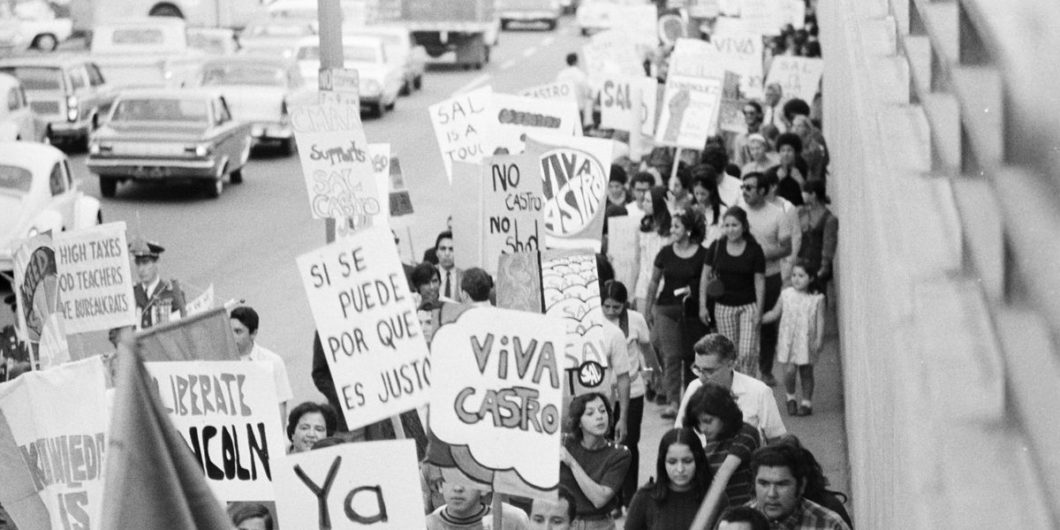Merit should be the only consideration in the college admission process.
An American Cultural Revolution?
The left is in the final stages of executing a top-down cultural revolution in America, argues Mike Gonzalez in this important book. The Plot to Change America lifts the lid on a half-century old New Left march through the country’s elite institutions. Their goal: to deconstruct the national story, replacing it with a neo-Marxist account of hierarchy and group conflict. The new national epic is about confessing the sins of the past to enter a millennium of equity and diversity. The fallen white oppressor redeems himself by agreeing to live in a state of permanent repentance. In place of allegiance to the Constitution, the Founding, liberal principles of equal treatment and an optimistic view of American history comes the usual hierarchy of racial and sexual victim groups at the top and white male oppressor at the bottom. Equal treatment even if resulting in somewhat unequal outcomes is to be replaced with unequal treatment to engineer equal outcomes. Minorities are dissuaded from assimilating—encouraged to nurture separateness, marinate in historic grievances, and develop what Jonathan Haidt terms a “common enemy” form of identity, coalescing around manufactured categories such as “Asian-American” or “People of Color.”
Many lament the rise of identity politics, but Gonzalez goes beyond standard critiques, performing much-needed spadework to trace the left’s steady infiltration of universities, government agencies, courts, foundations, and school boards since the 1960s. His perspective as an assimilated Cuban-American lends authenticity and urgency to the book.
The Rise of the Hyphenated-American
The story begins in 1948-9, when Marxist organizer Saul Alinsky worked with the Los Angeles Mexican-American community to build an oppositional consciousness. This bore fruit with the 1949 election of leftist Ed Roybal to Los Angeles City Council. The radical Community Service Organization (CSO) was founded soon after. Its aim: to stoke a sense of grievance and minority distinctiveness among Chicanos, thereby furnishing a unified, motivated Democratic bloc. From there, newly minted activists Ernesto Galarza, Herman Gallegos, and Julian Samora founded La Raza in 1966, and began to connect with the progressive new liberal elites who had captured the wealthy foundations.
One such figure was Paul Ylvisaker, director of public affairs at the Ford Foundation. Ylvisaker granted a UCLA research team $650,000 in 1966 which framed its mission as raking up similarities between the Latino experience in the Southwest and that of African-Americans. Ford also established the Mexican American Legal Defense and Educational Fund (MALDEF) which agitated for Spanish-language ballots. What Ylvisaker sought was a “united front” among Latinos to complement other oppositional minority movements.
Meanwhile, the African-American race riots of the late 60s, argues Gonzalez, confronted Democratic policymakers with the conundrum of how to respond. The establishment, writes Gonzalez, “panicked,” ploughing money into racial preference programs like minority set-asides (for government contracts) and affirmative action. Latino and Asian groups were encouraged to participate in this effort, and flourished in the wake of policies originally targeted at African-Americans.
For Gonzalez, “Hispanic” and “Asian” are artificial, top-down constructs that held little meaning for concrete ethnic groups like Cubans, Mexicans, Chinese or Indians. Early attempts to cultivate resentment among Latinos were met with indifference or even hostility. Organizations like La Raza consisted of little more than a few well-connected intellectuals with access to money and political influencers. Likewise, Japanese-American Marxist Yuji Ichioka coined the term “Asian American” in 1966 and founded the Asian-American Political Alliance (AAPA). A Berkeley student radical, he drank from the wellsprings of Black Panther militancy and Maoism. Styling themselves after Mao’s Red Guards, these Asian-American activists hoped to rouse Asians into a cohesive body that could press their grievances alongside black and Hispanic groups. Again, these constructions lived mainly in the minds of Marxist intellectuals rather than the communities they claimed to represent.
Progressive activists worked tirelessly to breathe life into their newly fabricated pan-ethnic political categories. Those of an earlier generation who questioned whether Hispanics really were a separate race, and who believed in assimilation, like University of Texas’ George Sanchez, were accused of false-consciousness and having “gringo tendencies.” Meanwhile La Raza leader Samora and his colleagues twigged to the fact that racial recognition was key to accessing federal funds. With help from the courts, who ruled that Mexican-Americans were an “identifiable ethnic minority class” in 1971, they lobbied the Census Bureau to create a new “Hispanic” category in 1980, separate from whites. Once in motion, this took on a life of its own.
None of this had to do with changing demographics, argues Gonzalez. In the 1960s and 70s, Hispanics and Asians were small groups. Elite organizing, not grassroots demand, drove identity politics. The impetus, he adds, came largely from highly-educated whites imbued with the new cultural variety of Marxism that began with Critical Theory and emerged in the 1960s.
The Long March
The original Critical Theorists of the 1930s and 40s Frankfurt School—Adorno, Horkheimer, Marcuse—were frustrated at the failure of West European workers to make revolution. These emigrés came to America in the 40s, where they left behind a powerful intellectual legacy. Adorno and Horkheimer returned to Europe in the 50s, but Marcuse stayed on to become the avatar of the American New Left. Not only were his books Eros and Civilization (1955) and One Dimensional Man (1964) incredibly influential, but Marcuse personally tutored Black Panther Angela Davis in revolutionary doctrine.
Marcuse was a disciple of Antonio Gramsci, an Italian Marxist imprisoned by Mussolini, who advocated for the gradual takeover of institutions and upending of bourgeois national cultures. These, Gramsci believed, were a form of “false consciousness” that pacified the revolutionary impulses of the working class. Marcuse had lost hope in the American white worker but saw revolutionary potential in “the substratum of the outcasts and outsiders, the exploited and persecuted of other races and other colors.” Here is a classic statement of the so-called “turn of the left” from working-class historical materialism to identity politics and multiculturalism. As a kicker, Marcuse threw in the authoritarian idea of “repressive tolerance,” which advocated censoring the freedom of conservatives to express themselves, a seed which has blossomed into left-authoritarian cancel culture.
Fired by New Left ideas, the veterans of the sixties student revolts entered the gates of the rapidly expanding university system, foundations, federal agencies, and the judiciary. So began a stealth campaign to remake the culture by, to paraphrase communist Rudi Dutschke, “marching through the institutions” below the radar of democratic oversight.
The post-60s New Left, with its focus on hierarchy and group conflict, has captured the culture, and is taking it in an increasingly fundamentalist “woke” direction.
Nowhere is this more apparent than in the field of education. Sixties New Left ideas first made headway in universities, capturing the Education Schools that train many of the nation’s teachers. Civics lessons were steered away from inculcating pride in the nation’s history, liberal ideals, and the Constitution. Instead, they consistently emphasized the victim-oppressor narrative. The New York Times’ 1619 Project, which rides roughshod over historical accuracy in order to concoct a grievance-based American history and has been adopted in some school districts, shows how New Left critical race theory is shaping the next generation.
Progressive cultural activism is constantly seeking to innovate, taking things to new levels. In early 2019, New York City Education chancellor Richard Carranza ordered principals, central office supervisors, and superintendents in the 1,800-school system to undergo mandatory re-education to stamp out “white supremacy culture” and “implicit bias.” These “struggle sessions,” for Gonzalez, recall the brainwashing of Stalin’s USSR or Mao’s Cultural Revolution.
The account is highly persuasive, and Gonzalez is absolutely correct to focus on progressive entryism via the liberal institutions. The post-60s New Left, with its focus on hierarchy and group conflict, has captured the culture, and is taking it in an increasingly fundamentalist “woke” direction. This is emptying out the content of American nationhood, from its constitution to its history, social unity to freedom of speech.
He is right to finger white liberal activism as the engine of change, and to connect it to today’s Progressive Activists, who make up a tiny but influential 8 percent of the US population. Minority activists played their part, but much of the impetus came from the elite level. The mass grievances of Hispanics and Asians didn’t fuel identity politics. Instead, the nexus of white liberals, with access to money and power, and minority radicals, who sought to construct a power base, set the juggernaut in motion.
Gonzalez has a nuanced eye for the public institutions and bureaucratic levers that radical activists managed to commandeer. His focus on culture is bang on, as this is where progressives have waged their Gramscian quest to exert hegemony over how the nation perceives itself.
Invented Categories
This doesn’t mean I agree with everything in these pages. John Judis is not the progressive activist Gonzalez suggests, but a populist and left-wing nationalist who wants lower immigration and champions the American working-class. He may back a welfare state, but his progressivism is economic, and he would largely agree with much of this analysis. His work with Ruy Texeira was essentially empirical, a far cry from the millenarian celebration of white decline that entrances the identity left.
Gonzalez is of course correct to note that Hispanics and Asians are primarily attached to their narrower ethnicity rather than wider pan-ethnic categories. Yet this doesn’t preclude the fact that the larger categories have meaning. Just as someone may attach to being both Irish and white, French and European, survey work I’ve done shows that many Cubans, Mexicans or Puerto Ricans are also attached—albeit less strongly—to their outer “Hispanic” layer of identity. Asian is more confected, but Hispanic, like white, has meaning as a social category.
Census categorization did not create the social realities these groups represent, though categories tend to foreground the less meaningful Hispanic outer layer above the concrete ethnicities underneath. They also “racialize” the Hispanic category and direct spoils toward Latino elites. Gonzalez rightly notes that the census inflates Hispanic numbers through its “one-drop” rule that classifies someone with one Mexican grandparent and seven Anglo ones as Hispanic.
Still, on the ground, Ted Cruz and his children are—for all intents and purposes—white Americans, whatever the census says. So is the assimilated “Spanglo” who ticks the Hispanic box to gain an advantage. The rub for critical race theorists, of course, is that if “Hispanic” has a basis in social reality, “White” does too. Far from an invention designed to oppress POCs, it is as real a social group as the others.
Though Gonzalez overstates the invented quality of Hispanic identity, he’s correct that progressive activists have pushed a ‘common enemy’ version of Latino pan-ethnicity, and, as the considerable Hispanic and Asian Trump vote revealed, that this agitation has largely fallen on deaf ears. We should celebrate Gonzalez’ plea for a melting-pot America, in which newcomers assimilate to produce “Heinz 57” descendants. Limited government is a valuable tradition, and this should be taught as an American inheritance.
Nonetheless, Gonzalez might have said more about what it means to melt into the “Heinz 57” American ethnic majority, as distinct from the nation-state (which must include the unmelted). One reason ethnicity appeals to many is because it contains greater cultural richness and rootedness than a civic nationalism based on fealty to liberal democratic principles. Universalism might have been enough to hang national identity on in 1776, but it doesn’t provide much distinctiveness today. The National Conservatives that Gonzalez obliquely criticizes are therefore correct that civic national conceptions need to be underpinned by something rooted in everyday life. Majority identity needs to be given cultural content in the form of the collective memory and folk culture of the Anglo-Protestant settlers and those who have intermarried into this ever-enlarging ethnic core. Without these vernacular elements, there will always be a powerful draw towards multiculturalism.
With the electoral earthquakes of 2016, conservative politicians have begun to understand that focusing only on the material sphere while trying to stay on the PC left’s good side can only lead to the fulfillment of Conquest’s Second Law.
A final sore spot is that the book drastically underplays the complicity of America’s conservative establishment in the progressive cultural revolution. The American right between the 1970s and 2010s came to fixate on the neoconservative trinity of tax cuts, foreign adventurism and evangelical enthusiasms like faith-based charity. These were all “safe,” in that they avoided challenging the identity left’s sacred cows of race and gender. Where they didn’t actively assist identity politics—as with Nixon and affirmative action—they turned a blind eye to illegal immigration and the rewriting of American history. Instead of cheap talk about cutting the state, conservatives should have spent those decades figuring out how to reform and recapture it.
Restoring Conservative Politics
Can the Republic be salvaged? Gonzalez is truly excellent in identifying some of the concrete institutional work that conservatives and classical liberals will need to do if reason, cohesion and liberty are to be restored. State legislatures, says Gonzalez, have to wake up. If they did, they would realize that they have the power to “appoint members of governing boards, who in turn appoint the top administrators. They control the purse strings for universities, and have ultimate control over the K-12 curriculum. They can alter certification procedures and standards… even change education school governance and personnel practices.” More must emulate Indiana governor Mitch Daniels, who asked why Howard Zinn’s grievance-based American history text was being taught in the state’s schools. He called it a “truly execrable, anti-factual piece of disinformation that misstates American history on every page,” and was roundly attacked by the educational establishment. Conservatives are going to need to find the stomach, focus and patience to engage in these battles.
Gonzalez calls for a “crusade for the curriculum” and cites both William Bennett, Reagan’s education secretary, and Robert Pondisco, who nails the matter precisely:
Where conservatives have grown wary and suspicious of meddling in curricula, activists and advocates on the Left have demonstrated far less reticence about imposing their views, moving further from the unifying impulse undergirding the entire purpose of public education.
This is going to require a passionate political campaign to rally the electorate, claims Gonzalez, as it will be ferociously resisted by the education establishment. All of which brings to mind historian Robert Conquest’s Second Law of Politics, that “Any organization not explicitly and constitutionally right-wing will sooner or later become left-wing.” With the electoral earthquakes of 2016, conservative politicians have begun to understand that focusing only on the material sphere while trying to stay on the PC left’s good side can only lead to the fulfillment of Conquest’s Second Law. Instead, reformers must treat every one of the country’s elite institutions like the Supreme Court: an institution to be politically contested until it reflects the mores of the median voter rather than the progressive bubble. A steady, forensic march back through the institutions, of the kind Gonzalez recommends, will be required. This to halt and then reverse the increasingly irrational elements of progressivism, which seek to erase traditional American identity and install an Orwellian blend of newspeak and right-think in place of free speech and objective truth.



